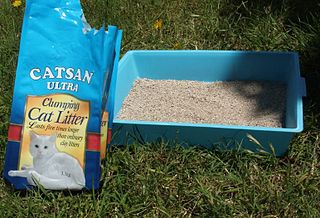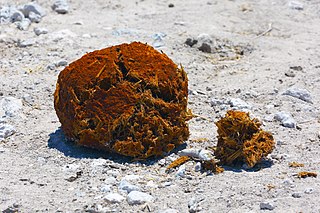| Look up litter in Wiktionary, the free dictionary. |
Litter is trash in small portions thrown inappropriately in a public place.
Contents
Litter may refer to:
| Look up litter in Wiktionary, the free dictionary. |
Litter is trash in small portions thrown inappropriately in a public place.
Litter may refer to:
| This disambiguation page lists articles associated with the title Litter. If an internal link led you here, you may wish to change the link to point directly to the intended article. |

Compost is organic matter that has been decomposed in a process called composting. This process recycles various organic materials otherwise regarded as waste products and produces a soil conditioner.

Coprophagia or coprophagy is the consumption of feces. The word is derived from the Greek κόπρος copros, "feces" and φαγεῖν phagein, "to eat". Coprophagy refers to many kinds of feces-eating, including eating feces of other species (heterospecifics), of other individuals (allocoprophagy), or one's own (autocoprophagy) – those once deposited or taken directly from the anus.

Wastewater is any water that has been affected by human use. Wastewater is "used water from any combination of domestic, industrial, commercial or agricultural activities, surface runoff or stormwater, and any sewer inflow or sewer infiltration". Therefore, wastewater is a byproduct of domestic, industrial, commercial or agricultural activities. The characteristics of wastewater vary depending on the source. Types of wastewater include: domestic wastewater from households, municipal wastewater from communities and industrial wastewater. Wastewater can contain physical, chemical and biological pollutants.

Excretion is a process by which metabolic waste is eliminated from an organism. In vertebrates this is primarily carried out by the lungs, kidneys and skin. This is in contrast with secretion, where the substance may have specific tasks after leaving the cell. Excretion is an essential process in all forms of life. For example, in mammals urine is expelled through the urethra, which is part of the excretory system. In unicellular organisms, waste products are discharged directly through the surface of the cell.

A litter box, sometimes called a sandbox, litter tray, cat pan, or litter pan, is an indoor feces and urine collection box for cats, as well as rabbits, ferrets, miniature pigs, small dogs, and other pets that instinctively or through training will make use of such a repository. They are provided for pets that are permitted free roam of a home but who cannot or do not always go outside to excrete their metabolic waste. Many owners of these animals prefer not to let them roam outside for fear that they might succumb to outdoor dangers, such as weather, wildlife, or traffic. A litter box makes it possible to shelter pets from these risks.

Housebreaking or house-training is the process of training a domesticated animal that lives with its human owners in a house or other residence to excrete outdoors, or in a designated indoor area, rather than randomly inside the house following its instinctive behaviour.

A composting toilet is a type of dry toilet that treats human excreta by a biological process called composting. This process leads to the decomposition of organic matter and turns human excreta into compost-like material but does not destroy all pathogens. Composting is carried out by microorganisms under controlled aerobic conditions. Most composting toilets use no water for flushing and are therefore called "dry toilets".
Spray or spraying commonly refer to:

In biology, detritus is dead particulate organic material, as distinguished from dissolved organic material. Detritus typically includes the bodies or fragments of bodies of dead organisms, and fecal material. Detritus typically hosts communities of microorganisms that colonize and decompose, i. e., remineralize, it. In terrestrial ecosystems it is present as leaf litter and other organic matter that is intermixed with soil, which is denominated "soil organic matter". The detritus of aquatic ecosystems is organic material that is suspended in the water and accumulates in depositions on the floor of the body of water; when this floor is a seabed, such a deposition is denominated "marine snow".
A treebog is a type of low-tech compost toilet. It consists of a raised platform above a compost pile surrounded by densely planted willow trees or other nutrient-hungry vegetation. It can be considered an example of permaculture design, as it functions as a system for converting urine and feces to biomass, without the need to handle excreta.

Animal repellents are products designed to keep certain animals away from objects, areas, people, plants, or other animals.
Metabolic wastes or excretements are substances left over from metabolic processes (such as cellular respiration) which cannot be used by the organism (they are surplus or toxic), and must therefore be excreted. This includes nitrogen compounds, water, CO2, phosphates, sulphates, etc. Animals treat these compounds as excretes. Plants have chemical "machinery" which transforms some of them (primarily the nitrogen compounds) into useful substances, and it has been shown by Brian J. Ford that abscised leaves also carry wastes away from the parent plant. In this way, Ford argues that the shed leaf acts as an excretory (an organ carrying away excretory products).

The bushy-tailed woodrat, or packrat is a species of rodent in the family Cricetidae found in Canada and the United States. Its natural habitats are boreal forests, temperate forests, dry savanna, temperate shrubland, and temperate grassland.
Crap or craps may refer to:

Cat training is the process of modifying a domestic cat's behavior for entertainment or companionship purposes. Training is commonly used to reduce unwanted or problematic behaviors in domestic cats, to enhance interactions between humans and pet cats, and to allow them to coexist comfortably. There are various methods for training cats which employ different balances between reward and punishment.

Feces are the solid or semisolid remains of food that could not be digested in the small intestine. Bacteria in the large intestine further break down the material. Feces contain a relatively small amount of metabolic waste products such as bacterially altered bilirubin, and the dead epithelial cells from the lining of the gut.

Urine diversion, also called urine separation or source separation, refers to the separate collection of human urine and feces at the point of their production, i.e. at the toilet or urinal. Separation of urine from feces allows human waste to be treated separately and used as a potential resource. Applications are typically found where connection to a sewer-based sanitation system is not available or areas where water supplies are limited.

Manure is organic matter, mostly derived from animal feces except in the case of green manure, which can be used as organic fertilizer in agriculture. Manures contribute to the fertility of the soil by adding organic matter and nutrients, such as nitrogen, that are utilised by bacteria, fungi and other organisms in the soil. Higher organisms then feed on the fungi and bacteria in a chain of life that comprises the soil food web.

A urine-diverting dry toilet (UDDT) is a type of dry toilet with urine diversion that can be used to provide safe, affordable sanitation in a variety of contexts worldwide. The separate collection of feces and urine without any flush water has many advantages, such as odor-free operation and pathogen reduction by drying. While dried feces and urine harvested from UDDTs can be and routinely are used in agriculture, many UDDTs installations do not apply any sort of recovery scheme. The UDDT is an example of a technology that can be used to achieve a sustainable sanitation system. This dry excreta management system is an alternative to pit latrines and flush toilets, especially where water is scarce, a connection to a sewer system and centralized wastewater treatment plant is not feasible or desired, fertilizer and soil conditioner are needed for agriculture, or groundwater pollution should be minimized.

Reuse of human waste refers to the safe, beneficial use of animal or human waste, i.e. feces and urine. Such beneficial use involves mainly the nutrient, organic matter and energy contained in human waste, rather than the water content. Reuse of human waste can involve using it as a soil conditioner or fertilizer in agriculture, gardening, aquaculture, or horticultural activities. Human waste can also be used as a fuel source or as a building material.